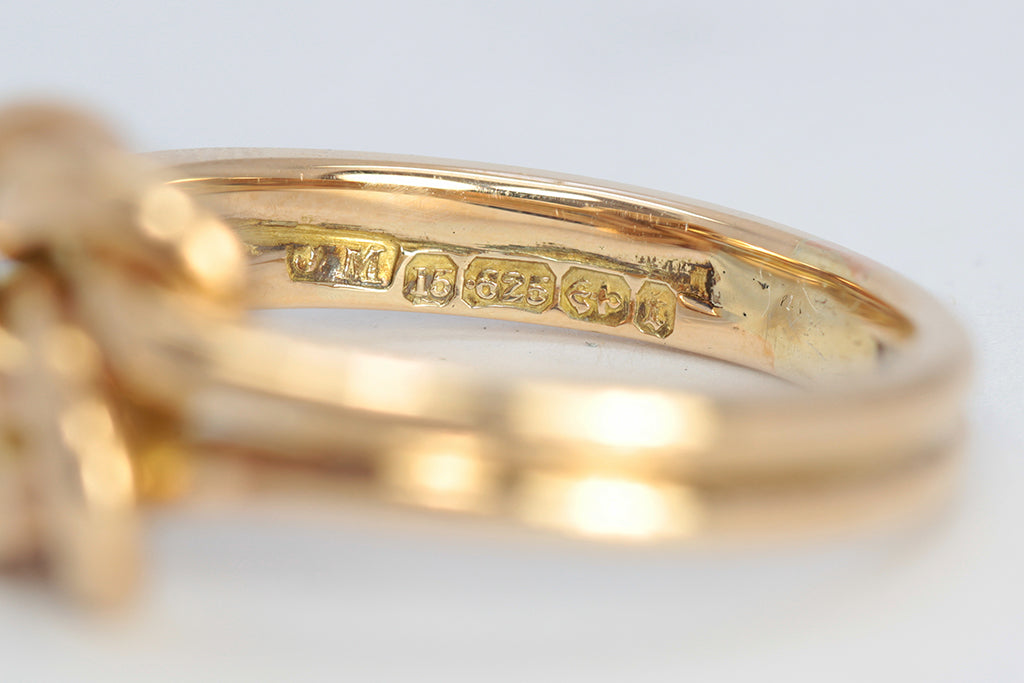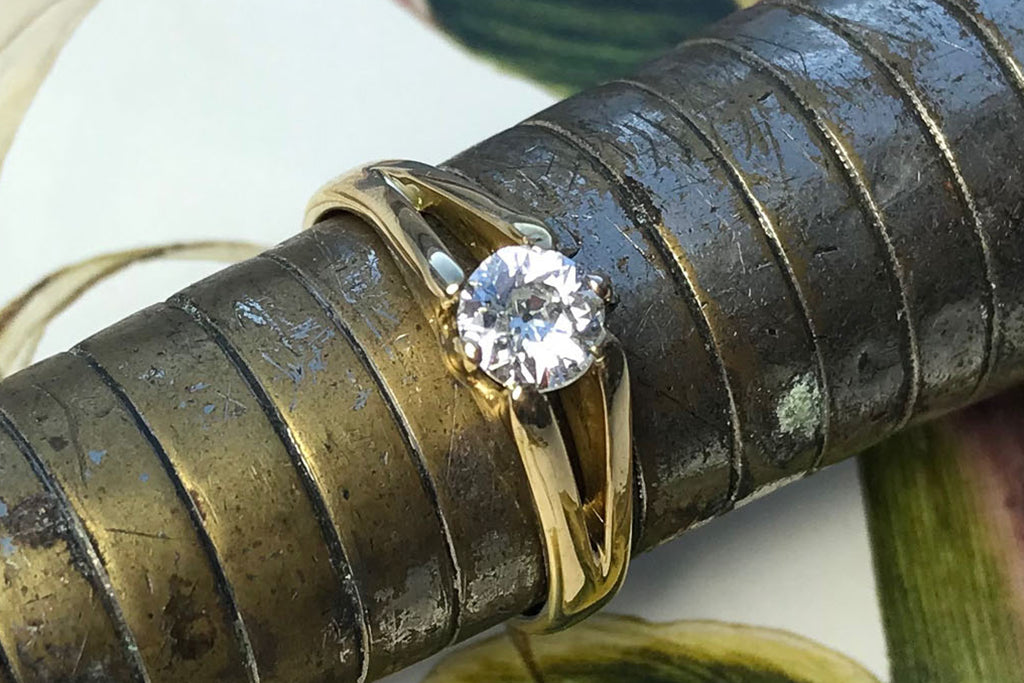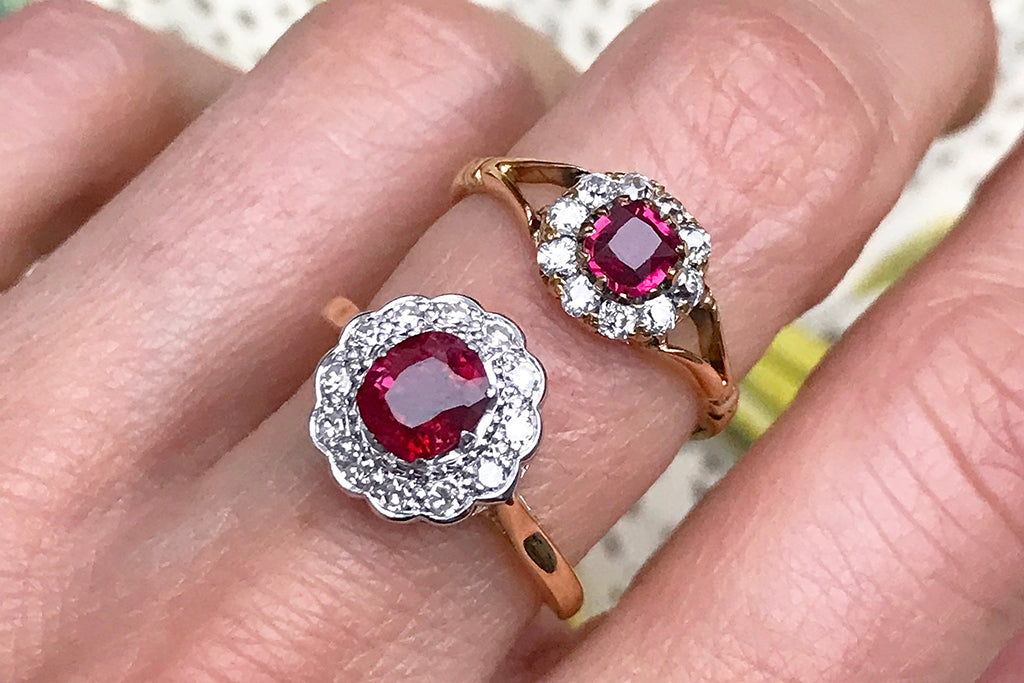
Do antique rings have hallmarks?
Whilst exploring the world of antique and vintage jewellery, one might expect to find the kind of hallmark that is standard of modern jewellery - a small stamp indicating the piece's origin, metal content and maker. However, it's not uncommon to encounter antique rings without any visible hallmarks, an absence that often raises questions. This blog post traverses the history and function of hallmarks, how to read them, and why a vintage piece of jewellery might lack one.
What is a hallmark?

Emily, our Art Deco cluster ring, stamped ‘18CT’
A hallmark is a legally recognised stamp applied to precious metal items, certifying their purity and origin. In the UK, hallmarking dates back to the 14th century, serving as a guarantee of quality and authenticity. These marks typically include:
- Metal fineness: Indicates the purity of the metal (e.g., 925 for sterling silver)
- Assay Office mark: Denotes the office that tested and marked the item
- Date letter: Represents the year the item was hallmarked (a legal requirement up until 1998)
- Maker's mark: Identifies the individual or company responsible for the item's production
These marks provide us with valuable information about a piece's history and authenticity.
What are the hallmarks on antique jewellery?

The hallmarks branded into Matilda, our Victorian lover’s knot ring. These include ‘15’ and ‘625’ for 15ct gold, the anchor denoting the Birmingham Assay Office, the year (1893) and ‘J.M’, the maker’s mark
Almost any piece of jewellery created in silver, gold, platinum or palladium in the UK from 1478 onwards will have visited an Assay Office for testing and hallmarking by a government official.
Common metal purity hallmarks in 21st century Britain include 925 (sterling silver), 750 (18ct gold) and 950 (platinum). These numbers denote ‘parts pure’. (18ct gold, for example, consists of 75% pure gold.) These numeric symbols only became standardised at various points throughout the 19th and 20th centuries, however. That’s why an Edwardian ring like Esme, for example, is simply stamped ‘18’ – or why mid-century Arabela’s platinum can be identified by a mark reading ‘PLAT’.
The maker’s mark can take almost any form, but it must be one-of-a-kind, and nearly always consists of a logo or a set of two initials.
The Assay Office mark reflects which of the four Assay cities the jewel was verified in. Since 1300 London has been denoted by the leopard’s head, derived from the royal arms. Later, in 1485, the three-towered Edinburgh Castle was taken from Scotland’s coat of arms and cemented as the hallmark for Edinburgh. Legend has it that meetings prior to the inauguration of both Birmingham and Sheffield Assay Offices in 1773 were held at a pub called the Crown & Anchor Tavern on the Strand, London, where the choice of symbol was made on the toss of a coin. As a result, Birmingham adopted the Anchor and Sheffield the Crown (which was changed in 1977 to the White Rose of York).
Date letter hallmarking became a legal requirement in the UK under the Hallmarking Act of 1973. However, in 1998, the British government abolished the compulsory use of date letters for hallmarking purposes and date letters have since become optional.
Why might an antique ring lack hallmarks?

While hallmarks are common, their absence on antique rings isn't unusual. Several factors can contribute to this:
1. Wear and tear over time
Decades or even centuries of wear can erode hallmarks, making them faint or entirely invisible. Daily use, polishing, and exposure to elements such as cosmetic products and the skin’s natural acidity are all culprits for the gradual degradation of metal.
2. Resizing and repairs
Modifications to a ring, such as resizing or repairing, can result in the removal or distortion of original hallmarks. Jewellers may cut or reshape parts of the band, inadvertently affecting the stamped areas.
3. Original absence of hallmarks
Not all antique jewellery was hallmarked in the first place. Before the Hallmarking Act of 1973, hallmarking regulations were less stringent, and some pieces, especially those made by independent or foreign artisans, were often sent off into the world without any official markings.
4. Foreign origins
Rings crafted outside the UK often follow different hallmarking systems, or none at all. For instance, French jewellery uses a different set of symbols, whilst some countries didn't implement hallmarking until more recently.
5. Counterfeit or altered marks
Unfortunately, counterfeit vintage rings with fake or altered hallmarks do exist, with unofficial marks often added to increase perceived value. It's essential to buy from reputable sellers and seek an expert appraisal when in doubt.
Can an antique ring be authenticated without a hallmark?
 Pamela, our Edwardian dress ring, whose markings have been assessed as ‘indistinct’
Pamela, our Edwardian dress ring, whose markings have been assessed as ‘indistinct’
The absence of a hallmark doesn't necessarily indicate a lack of authenticity. Thankfully, experts can assess other factors to ascertain the age and legitimacy of a piece:
1. Craftsmanship and design
Handcrafted details and techniques can hint at a specific era. For example, the intricate filigree work of Edwardian rings or the bold geometric patterns of Art Deco pieces may provide clues about the ring's age.
2. Precious materials
Certain materials were popular during specific periods of history due to trends or widespread availability – whilst the discovery, trade and use of others are more recent additions to jewellery designs. An appraiser well-versed in history may be able to read the presence of certain materials not only as indicators of a piece’s age, but its origin location.
3. Wear patterns
Natural wear patterns, such as oxidisation or the softening of patina, can indicate age and authenticity. They can also help us to draw quick conclusions on the materials present without the help of hallmarks or documentation.
The Vintage Ring Co. works closely with a highly skilled valuer at the Goldsmiths’ Assay Office in London, who gleans as much information as he possibly can from each pre-loved ring and shares it via our unique certificate of authenticity.
Are Hallmarks Important?

Whilst hallmarks undeniably offer value and traceability, their absence doesn't diminish a ring's worth. By examining craftsmanship, materials, and design, we can connect the dots to appreciate the true value of antique rings through understanding the contexts that gave rise to them. If you're curious about the origins of a piece of jewellery, we at The Vintage Ring Co. pride ourselves on our attention to detail and our passion for beautiful old things – we’re here to help.


